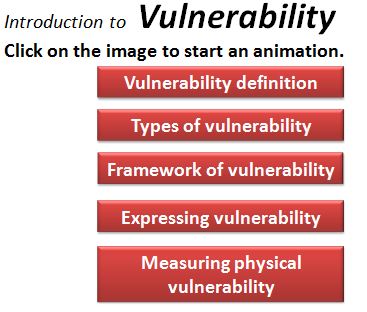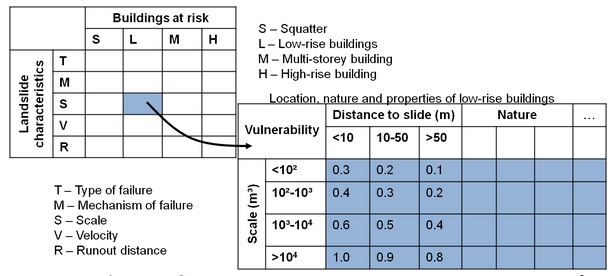By:
Introduction
This section gives an introduction to vulnerability and its role in Disaster Management.
Complexity
The concept originated from the social sciences in response to the pure hazard-oriented perception of disaster risk in the 1970s. Since that time, different disciplines have developed their own concepts.
Through the last decades several paradigm shifts of risk and vulnerability have taken place:
-
Technocratic or Behavioral paradigm: The first approaches to risk were the ones that assimilated it to hazard focused mainly on it, carried out especially by professionals of the natural sciences (geologists, engineers, meteorologists, etc.). According to Blaikie et al (1994), until the emergence of the idea of vulnerability to explain disasters, there was a range of prevailing views. None of which really dealt with the issue of how society creates the conditions in which people face hazards differently. The first approach was unapologetically naturalist, in which all blame was apportioned to "the violent forces of nature". Governments and individuals relied upon physical protection against the hazards.
-
Physical Vulnerability or Structural paradigm: The concept of vulnerability entered the risk scene. Protection was defined not only according to the physical protection systems built, but also according to the people"s behavior. This inclusion of people's behavior led to the design and use of early warning systems and educational programs about hazards and how to protect against them. This paradigm lasted for a couple of decades and was even used during the Yokohama Strategy and Plan of Action for a Safer World (1994), where all the efforts were aimed towards increasing our scientific knowledge about the causes and consequences of natural hazards and facilitate its wider application to reducing vulnerability of disaster-prone communities. This perspective included overall development, attacking root causes, and capacity building.
-
Complexity paradigm: A new understanding of the complex interaction between nature and society has emerged, and as such, a new complex approach to understanding risk has to be undertaken. Vulnerability is not only about groups or individuals, but is also embedded in complex and social relations and processes.
The definitions of vulnerability
Multiple definitions and different conceptual frameworks of vulnerability exist, because several distinct groups have different views on vulnerability. Academic staff from different disciplines, disaster management agencies, development corporations, climatic change organization etc. An overview is given on the website of the ProVention Consortium and in the book on Vulnerability edited by Birkmann (2006). Several definitions are given below:
- The intrinsic and dynamic feature of an element at risk that determines the expected damage/harm resulting from a given hazardous event and is often even affected by the harmful event itself. Vulnerability changes continuously over time and is driven by physical, social, economic and environmental factors" (UNU-EHS, 2006 ).
- "The potential to suffer harm or loss, related to the capacity to anticipate a hazard, cope with it, resist it and recover from its impact. Both vulnerability and its antithesis, resilience, are determined by physical, environmental, social, economic, political, cultural and institutional factors" (Provention Consortium, 2007).
- Vulnerability is related to the characteristics and circumstances of a community or system, these characteristics and circumstances make community or system susceptible to hazard and cause loss. There are many aspects of vulnerability, arising from various physical, social, economic, and environmental factors. Examples may include poor design and construction of buildings, inadequate protection of assets, lack of public information and awareness, limited official recognition of risks and preparedness measures, and disregard for wise environmental management (UN-ISDR, 2009).
- Vulnerability = (Exposure ) + (Resistance) + (Resilience)
With: Exposure: at risk property and population;
Resistance: Measures taken to prevent, avoid or reduce loss;
Resilience: Ability to recover prior state or achieve desired post-disaster state.
Coping capacity:"The ability of people, organizations and systems, using available skills and resources, to face and manage adverse conditions, emergencies or disasters" The capacity to cope requires continuing awareness, resources and good management, both in normal times as well as during crises or adverse conditions. Coping capacities contribute to the reduction of disaster risks (UN-ISDR, 2009).
Resilience: "the ability of resistance, absorption, adaptation and recovery of a system from the effects of hazard, including preserving and restoring the basic structures and functions". This depends on the necessary resources and organizing capability for the community before and after a disruptive event. Building disaster resilience can help community to be better prepared to the disasters and recovery fast after the disasters (UN-ISDR, 2009). (Watch an introduction video about disaster risk reduction and resilience)
What is common from the definitions is that vulnerability is: Multi-dimensional (e.g. physical, social, economic, environmental, institutional, and human factors define vulnerability);Dynamic (vulnerability changes over time); Scale-dependent (vulnerability can be expressed at different scales from human to household to community to country resolution; Site-specific (each location might need its own approach). And resilience is related to different phases before and after a disruptive event, including the preparation before disasters, impact of disasters and recovery after disasters and long time impact of disasters. One of the relationships between vulnerability and resilience will be discussed below in paragraph "framework of vulnerability".
The different types of vulnerability
In the table below four different types of vulnerability have been identified, Human-social, Physical, Economic and Environmental and their associated direct and indirect losses. The table gives examples of types of losses. The ones indicated in red are those that are most frequently evaluated.

Table 1: overview of types of losses
According to the different types of losses, the vulnerability can be defined as physical vulnerability, economic vulnerability, social vulnerability and environmental vulnerability.
- Physical Vulnerability: meaning the potential for physical impact on the physical environment - which can be expressed as elements-at-risk (EaR). The degree of loss to a given EaR or set of EaR resulting from the occurrence of a natural phenomenon of a given magnitude and expressed on a scale from 0 (no damage) to 1 (total damage)".
- Economic vulnerability: the potential impacts of hazards on economic assets and processes (i.e. business interruption, secondary effects such as increased poverty and job loss) Vulnerability of different economic sectors.
- Social vulnerability: the potential impacts of events on groups such as the poor, single parent households, pregnant or lactating women, the handicapped, children, and elderly; consider public awareness of risk, ability of groups to self-cope with catastrophes, and status of institutional structures designed to help them cope.
- Environmental vulnerability: the potential impacts of events on the environment(flora, fauna, ecosystems, biodiversity).
Conceptual framework of vulnerability
In the last decades different frameworks on vulnerability were developed. In this paragraph we will look at a number of them. A good overview is given by Birkmann, 2006. 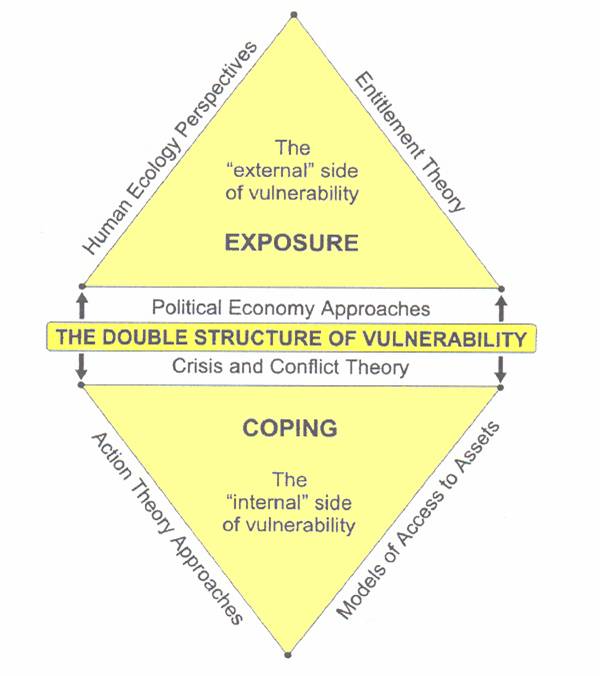
- The double structure of vulnerability
According to Bohle (2001), vulnerability is seen as having two sides: an internal side and an external side. The external side related to the exposure to risks and shocks and is influenced by Political Economic approaches ( e.g. social inequalities, assets control by upper classes), Human Ecology Perspectives (population dynamics and capacities to manage the environment) and the Entitlement Theory (relates vulnerability to the incapacity of people to obtain or manage assets via legitimate economic means). The internal side is called coping and relates to the capacity to anticipate, cope with, resist and recover from the impact of a hazard and is influenced by the Crisis and Conflict Theory (control of assets and resources, capacities to manage crisis situations and resolve conflicts), Action Theory Approaches (how people act and react freely or as a result of societal, economical or governmental constraints) and Models of Access to Assets (mitigation of vulnerability via access to assets).
Figure 2: Bohle's conceptual framework for vulnerability analysis.(Source: Bohle, 2001 in Birkmann, 2006)
- Pelling model
In the framework for vulnerability proposed by Pelling (2003) human vulnerability is defined by: exposure, resistance and resilience. Exposure is related to the location and characteristics of the hazard; resistance is related to the economical, psychological, and physical health, as well as the capacity of individuals or communities to withstand the impact of the event and is related with livelihoods; resilience is defined as the ability to cope with or adapt to the hazard stress through preparedness and spontaneous adaptations once the event has manifested itself.

Figure 3: Exposure, resistance, resilience model (Pelling, 2003)
- MOVE framework
Figure 4 presents a framework for vulnerability assessment that was developed under the EU FP7 MOVE project. The MOVE generic concept of vulnerability includes different components and is set within a holistic framework of risk assessment, governance and management. The MOVE conceptual framework presented in addresses vulnerability and risk to natural hazards from a holistic and multidimensional point of view. The framework illustrates two concepts: 1)Risk is the result of the exposure of society to hazards, in time and space , and of the vulnerability of the society. 2)Risk management and adaptation aim to modify the initial vulnerability conditions or hazards.
Hazard propagation will expose a particular area and its society. Vulnerability is a combined result of exposure, susceptibility (fragility) and resilience (capacity to anticipate, cope and recover). Identification and awareness of hazards, vulnerability and risk are essential steps to establish effective management of risk caused by geological, hydro-meteorological and anthropogenic or technological hazards. Susceptibility and fragility are vulnerability conditions that reflect the predisposition (weaknesses and lack of strength) that can be expressed in physical, social, environmental or economic terms. The lack of resilience is another important vulnerability factor that reflects the capacity level of a society to anticipate (to intervene proactively the risk conditions), to adapt (to be prepared to face future hazardous events), as well as to cope and recover effectively when such events occur. A lack of these capacities increases the vulnerability of the society.
Expressing vulnerability
Vulnerability can be expressed or presented in various ways. Vulnerability indices are based on indicators of vulnerability and are mostly used for holistic vulnerability, capacity and resilience assessment. Vulnerability tables show the relation between hazard intensity and degree of damage in the form of a table. Vulnerability curves display the relation between hazard intensity and degree of damage for a group of elements-at-risk (e.g. a certain building type) ranging from 0 to 1. Different types of elements-at-risk will show different levels of damage given the same intensity of hazard. Vulnerability curves can be relative curves (showing the percentage of property value damaged) or absolute (show the absolute amount of damage). Fragility curves provide the probability for a particular group of element at risk to be in or exceeding a certain damage state (e.g. complete destruction, extensive damage, moderate damage, and slight damage) under a given hazard intensity. A damage probability matrix (DPM) indicates the probability that a given structural typology will be in a given damage state for a given intensity.
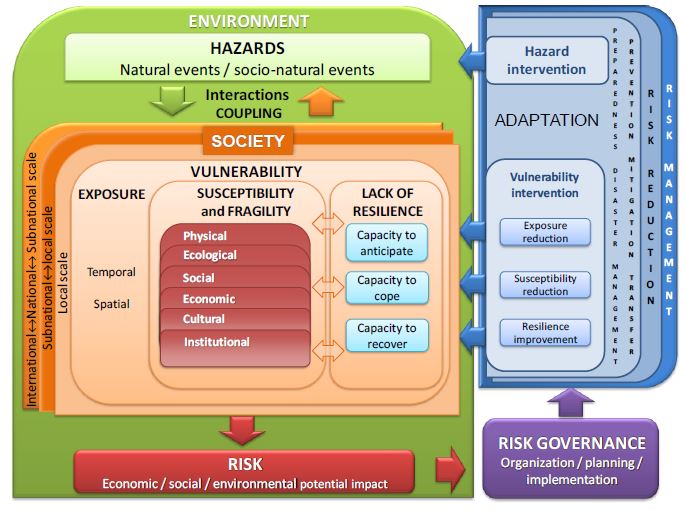 |
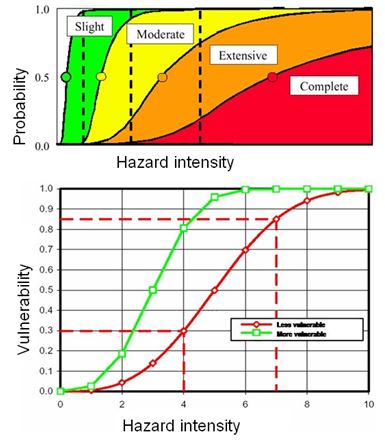 |
| Figure 4: the MOVE framework (Birkmann et al 2013) | Figure 5: Fragility curve (above) and vulnerability curve(below) |
For more information about the MOVE framework, MOVE Manual and MOVE Handbook, click here.
For watching the introduction about disaster risk reduction and resilience, click here.
Measuring physical vulnerability
Measuring physical vulnerability is a complicated process, and can be done using either empirical or analytical methods. Empirical methods are either based on damage data from historical hazard events, or on expert opinion. For events that are relatively frequent and widespread it is possible to collect information on the degree of physical damage to buildings or infrastructure after the event has occurred. This method is particularly suited for flooding and for earthquakes, which normally affect many buildings that are of the same type, and allow generating large enough samples in order to make a correlation between the hazard intensity (e.g. modified Mercalli intensity, ground acceleration, water depth etc) and the degree of damage. The result is either a damage probability matrix (DPM) or a vulnerability curve. In many situations expert opinion will be the most feasible option for obtaining vulnerability information, either because there is no prior damage information, not enough funding to apply analytical methods or because building classifications used elsewhere do not reflect the local building stock. This method involves the consultation of a group of experts on vulnerability to give their opinion e.g. on the percentage damage they expect for the different structural types with different intensities of hazard.
Analytical methods study the behavior of buildings and structures based on engineering design criteria, analyzing e.g. seismic load and derive the likelihood of failure, using physical modelling tests (e.g. shake tables or wind tunnels), as well as computer simulation techniques. In the analytical methods the information on the intensity of the hazard should be more detailed. For instance in the case of flood, the different flood parameters (duration, velocity, impact pressure, etc.) are directly controlled during laboratory experiments and their effects on the structures are quantified. This type of approaches are resource demanding (time and money) but allow for a better understanding of the relation between flood intensity and degree of damage for an exposed structure with definite characteristics. Moreover, due to data/resources requirement, they can only be used for assessment of individual structures (Ciurean et al 2013).
Example 1: Flood
- Empirical methods
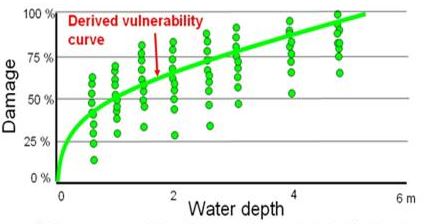
Figure 6: the derived vulnerability curve
The Dutch standard method (2004) has eleven relative depth-damage functions which are derived synthetically and are based on both damage data and expert judgment. The damage functions are mostly depth-damage functions. Only the damage factor for residential buildings additionally takes into account a critical velocity of inundation and the impact of waves caused by storms (Kok et al. 2004). The method is developed for meso-scale and uses aggregated land use data (See http://www.floodsite.net/). Examples of the damage function are given in figures 7, respectively for low- rise dwellings, intermediate high rise dwelling. 0
 |
 |
|
Figure 7: Depth-damage function of the Dutch standard method 2004 for low rise, intermediate high rise dwelling (Source; Huizinga,et al. , 2004). |
|
- Analytical methods
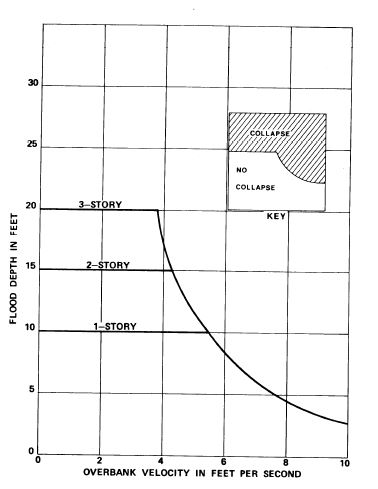
The figure indicates the velocity-depth function in the HAZUS-MH flood model, in which if the building collapse is assumed. A threshold is set for collapsed corresponding to 100% damage and the inundation level is only considered if the velocity value is below the threshold. Source: (FEMA Multi-hazards flood model)
For further reading about the HAZUS_MH Flood Model:
https://www.fema.gov/media-library/assets/documents/12331
Watch Shaketable test on Youtube:
https://www.youtube.com/watch?v=AL7Kh31tB2M&NR=1 Figure 8: Building Collapse Curve (USACE, 1985)
https://www.youtube.com/watch?v=kc652Zp5qWk&feature=related
For further reading about the analytical methods about earthquake:
Failure process of masonry buildings during earthquake and associated casualty risk evaluation (click here to read)
Example 2: Landslide
- Qualitative methods
A particular landslide type and the characteristics of the elements at risk are given and the appropriate vulnerability factor is assesses by expert judgment, field mapping or based on historical records.
An empirical GIS-based geomorphological approach for landslide and risk analysis was proposed by Cardinali at el (2002). The damage to structures and infrastructures was classified into 3 classes: superficial (aesthetic, minor) damage, where the functionality of buildings and roads is not compromised, and the damage can be repaired, rapidly and at low cost; functional (medium) damage, where the functionality of structures or infrastructures is compromised, and the damage takes time and large resources to be fixed; Structural (severe or total) damage, where buildings or transportation routes are severely or completely damaged, and require extensive (and costly) work to be fixed. In this category, demolition and reconstruction may be required (See table 2).
 |
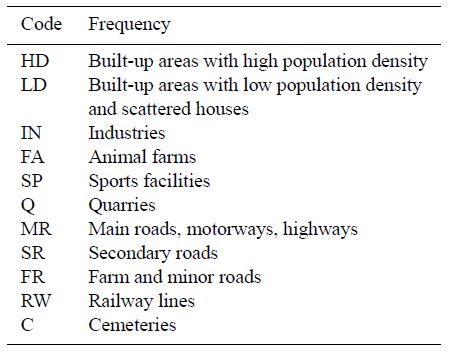 |
Table 2: Vulnerability, the expected damage to the elements at risk. A = superficial (aesthetical, minor) damage; F = functional (or medium)damage; S = structural (or total) damage. The table shows the expected damage to buildings and roads, and to the population if (i.e. where) affected by landslides of different type (rock fall, debris flow or slide)and intensity (slight, medium, high, or very high). The latter is a function of landslide volume and velocity. Source: Cardinali at el (2002).
For further reading:
A geomorphological approach to the estimation of landslide hazards and risk in Umbria, Central Italy (Click here to download)
- Semi-quantitative methods
"Semi-quantitative methods reduce the level of generalization. They are flexible and can, to a certain degree, reduce subjectivity, compared with the quantitative method. Damage matrices are used in this method which are composed by classified intensities and stepwise damage levels (Ciurean et al 2013). Figure 9 shows a correlation, in terms of vulnerability, between exposed elements and the characteristics of the hazard. This requires statistical analysis of detailed records on landslides and their consequences.
Figure 9: Structure vulnerability matrix. Source: (Winter et al 2012).
For further reading:
Determining the physical vulnerability of roads to debris flow by means of an expert judgment approach.
- Quantitative methods
"Quantitative methods are mostly applied at local scale (often, for individual structures) due to complexity of procedures involved and detailed data requirements. This rely on three types of analysis,expert judgment (heuristic), damage records (empirical) or statistical analysis (probabilistic).
Fuchs et al (2007) derived vulnerability curves for buildings according to the intensity of the event and the damage ratio based on the debris flow event which occurred in the Austrian Alps. The intensity was measured by deposit height and the susceptibility of the element at risk (i.e. buildings) by material of construction (brick, masonry, and concrete). Figure 10 shows the curve produced together with other existing curves for comparison.
Figure 10: Relationship between debris flow intensity and vulnerability is expressed by a second order polynomial function for flow height <2.5 m. Results from the study are indicated by black dots, the corresponding mean vulnerability is indicated by red dots. Source: Fuchs et al (2007).
For further reading:
Towards an empirical vulnerability function for use in debris flow risk assessment (Click here to download)
Measuring Physical Vulnerability for population
Population vulnerability can be subdivided into direct physical population vulnerability (injury, casualties, and homelessness) and indirect social vulnerability and capacity. Physical population vulnerability is mostly carried out after a building-vulnerability study by analyzing the effect of the building damage on the population inside, using different injury severity classes.
For landslides, population vulnerability have been measured based on expert opinion.Table 3 presents results on population vulnerability for the Hong Kong area for landslides, which are based on an extensive database of slope failures and associated injuries and casualties.

Table 3: Vulnerability of a person being affected by a landslide in open space, in a vehicle and in a building (Table 2, Glade 2003 "“ modified after Wong et al. 1997)
References
FEMA guide
There is a very useful guide prepared by FEMA called "Understanding your risks" that guides you through the various phases of a risk assessment. This guide is not ment for the use of GIS, but it is a very useful background reading document. The guide is also in the background materials of the course. You can also access it on: http://www.fema.gov/media-library/assets/documents/4241
Other references cited in the text:
ADPC 2004. Buildig Disaster Risk Reduction in Asia: A Way forward ADPC Looks Ahead to 2015. ADPC, Bangkok, Thailand
Apel, H., Aronica, G. T., Kreibich, H., and Thieken A. H.( 2009) Flood risk analyses—how detailed do we need to be? Nat Hazards (2009) 49:79–98
Birkmann, J. (2006:1). Measuring vulnerability to promote disaster-resilient societies:Conceptual frameworks and definitions. Measuring vulnerability to natural hazards : towards disaster resilient societies. J. Birkmann. Tokyo, United Nations University Press: 9-54.
Birkmann, J. (2005). Danger need not spell disaster – But how vulnerable are we? Research Brief of the United Nations University, United Nations University. No. 1/2005,.
Blaikie, P., T. Cannon, et al. (1994). At risk : natural hazards, people's vulnerability and disasters. London etc., Routledge
Bogardi, J. and J. Birkmann (2004). Vulnerability Assessment: the first step towards sustainable risk reduction. Disasters and Society - From hazard assessment to risk reduction. D. Malzahn and T. Plapp. Berlin, Logos Verlag: 75-82.
Bohle, H.G ( 2001) "Vulnerability and Critivallity: Perspectives from Social geography", IHDP update 2/2001, Newsletter of the International Human Dimensions Programme on Global Environmental Change: 1-
Bollin, C., Hidajat, R., 2006. Community-based disaster risk index: pilot implementation in Indonesia. In: Birkmann, J. (Ed.), Measuring Vulnerability to Natural Hazards—Towards Disaster Resilient Societies. UNU-Press, Tokyo, New York, Paris.
Bollin, C., Cárdenas, C., Hahn, h., Vatsa, K.S., (2003) Natural Disaster network; Disaster Risk management by Communities and Local Governments, Washington, d.C.: Inter-American Development Bank
Botero Fernandez, V., Ottens, H.F.L. (promotor) , van Westen, C.J. (promotor) and Sliuzas, R.V. (promotor) (2009) Geo - information for measuring vulnerability to earthquakes : a fitness for use approach. Enschede, Utrecht, ITC, University of Utrecht, 2009. ITC Dissertation 158, 191 p. ISBN: 978-90-6164-272-5
Buck W, Merkel U. (1999) Auswertung der HOWAS – Datenbank (Analysis of the HOWAS data base), Institut fu¨r Wasserwirtschaft und Kulturtechnik (IWK) der Universita¨t Karlsruhe, Karlsruhe, Report Nr. HY 98/15
BRGM, 2005 RISK-NAT (Module 4): Methods and tools for risk evaluation Progress report. BRGM 54041_FR
BRIENE M, KOPPERT S, KOOPMAN A, VERKENNIS A (2002), Financiele onderbouwing kengetallen hoogwaterschade, NEI B.V.
Buckle, Marsch and Smale (2000) New approaches to Assessing Vulnerability and resilience"Australian Journal of Emergency Management, Winrter 2008: 8-156
BUWAL/BWW/BRP, 1997. Berücksichtigung de Massen bewegungsgefahren bei raumwirksamen Tätigkeiten. Bundesamnt f Bundesamnt für Unwelt, wald und Lnadschaft (BUWAL), Bundesamnt für Wasserwirtschaft (BWR) , Bundesamnt für Raumplannung (BRP). Bern Empfehlungen, EDMZ 310.023d.
Cardona, O.D. (1999) Environmental Management and Disaster Prevention: Two Related topics: A Holistic Risk Assessment and management Approach, in: J.Ingleton, ed., Natural Disaster Management, London: Tudor Rose.
Cardona, O.D. (2003), "The need for rethinking the concept of vulnerability from a holistic perspective: a necessary review and criticism for effective risk management", in Bankoff, G., Frerks, G., Hillhorst, D. (Eds),Mapping Vulnerability: Disasters, Development and People, Earthscan, London, pp.37-51.
Clark, G.E. et al.,1998. Assessing the vulnerability of coastal communities to extreme storms: the case of Revere, MA., USA. Mitigation and Adaptation Strategies for Global Change, 3(1):59-82.
Cutter, S.L. (1993), Living with Risk, Edward Arnold, London, .
utter, S.L., B.J. Boruff, and W.L. Shirley. 2003. “Social Vulnerability to Environmental Hazards.”Social Science Quarterly84(1): 242-261.
Davidson, R. (1997) An Urban earthquake Risk Index, The John A Blume Earthquake Engineering Center, department of Civil engineering, report No 121, Standford: Stanford University.
European Spatial Planning Observation Network (2003). Glossary of terms., Copyright © GTK Webmaster http://www.gsf.fi/projects/espon/glossary.htm.FloodSite, E. P.-R. Frank Messner, Colin Green, Volker, et al. (2007). Evaluating flood damages: guidance and recommendations on principles and methods, Co-ordinator: HR Wallingford, UK
Flageolet, J.C., (1999) Landslide hazard - a conceptual approach in risk viewpoint. In: R. Casale and C. Margiotinni (eds) Floods and Landslides : Integrated Risk Assessment ( Berlin: Springer Verlag) 3-18
Furukawa, Aiko and Ohta, yutaka (2009) Failure process of masonry buildings during earthquake and associated casualty risk evaluation. Nat Hazards (2009) 49:25–51
Gewalt M, Klaus J, Peerbolte E.B, Pflügner W, Schmidtker F, Verhage L, (1996) EUROflood _ Technical Annex 8 Economic Assessment of Flood Hazards.
Geoscience Australia 2008. Australian Government
Glade T (2003), Vulnerability Assessment in landslide risk Analysis, Die Erde, 134(2), 123-146.
Glade, T. Anderson, M., and Crozier M.J. (2005) Eds, Landslide Hazard and Risk. Wiley
Granger, K. (2000) Community risk in Mackay A multi hazard risk assessment . Cities Project Chapter 1. Urban Geohazard Risk Assessment online: http://www.ga.gov.au/image_cache/GA4178.pdfHahn, H., J. C. Villagrán De León, et al. (2003). Indicators and Other Instruments for Local Risk Management for Communities and Local Governments. Document prepared as part of the documents related to the Project: Local Risk Management for Communities and Local Governments. G. f. I. The German Technical Cooperation Agency. http://www.ga.gov.au/hazards/risk/vulnerability.jsp
Huizinga, H.J., Dijkman, M., Waterman, R., en Barendregt, A. , 2004. HIS- Schade en Slachtoffer Module Versie 2.1, Systeemdocumentatie. HKV LIJN IN WATER en Geodan IT. November 2004.
Imiriland (2002) Identification and Mitigation of Large Landslide Risks in Europe . Project Imiriland D 16. relevant criteria to assess vulnerability and risk. Regione Piemonte in collaboratione with Politecnico di Torino, École polytechnique fédérale de Lausanne, C.N.R. di geoscienze e georisorse di Torino.( ppt)
Imiriland (2004) Identification and Mitigation of Large Landslide Risks in Europe. Project Imiriland : Advances in Risk Assessment Editors: Bonnard Ch, Forlati F, Scavia C.
ITC (2001). ILWIS 3.0 Academic - User's Guide. Enschede, Netherlands, ITC.
Intergovernmental Panel for Climate Change (IPCC) (2001) Climate Change 2001. Synthesis report: A contribution of Working Groups I, II, and III to the third assessment report . R.T Watson, et al eds, Cambridge/New York Cambridge University Press
Kasperson, J.X., Kasperson, R.E., Turner, B.L. II, Schiller, A.M.D., Hsieh, W. (2005), "Vulnerability to global environmental change", in Kasperson, J.X., Turner, B.L. II, Schiller, A.M.D., Hsieh, W. (Eds),Social Contours of Risk. II: Risk Analysis Corporations and the Globalization of Risk, Earthscan, London, pp.245-85.
Kok, M., Huizinga, H.J., Vrouwenvelder, Barendrecht A (2004). Standaard methode
2004, Damage and Casualties caused by Flooding, Client: Highway and Hydraulic engineering department.
Lang K, 2002 Seismic vulnerability of existing buildings. PhD thesis Institurte of Structural Engineering, Swiss federal Institute of Technology.
MATE/METL, 1999. plans de Prevention des Risques Naturels (PPR): Risques de Mouvement de Terrain. Ministère de de l’Amenagement du Territoire et de l’Environment (MATE), Ministère de l’Equipement, des Transport et du Logement (METL). Paris: La documentation Francaise.
Messner F, Meyer V, (2005) Flood damage, vulnerability and risk perception – challenges for flood damage research, UFZ Discussion Paper 13/2005
Maquaire, O., Thiery, Y and Malet J.P. Current practices and assessment tools of landslide vulnerability inmountainous basins – identification of exposed elements with a semi_automatic procedure.
Mejia Navarro,M & Garcia, L.A., 1996 Natural Hazard and risk Assessment using Decision Support System. Application. Environmental and Engineering Geosciences 2 (3): 299-324
Mileti, D.S. (1999 Disasters by Design: A Reassessment of Natural Hazards in the United States, Brookfield: Rothstein Associates.
Pelling, M. (2003) The Vulnerability of Cities. Natural disasters and Social Resilience. Earthscasn Publications, London.
Penning-Rowsell E.C. , Johnson C, Tunstall S, Morris J, ChattertonJ, Cokera A, Green C, (2003) The benefits of flood and coastal defence techniques and data for 2003, flood hazard Research Centre, Middlesex University.
Remondo, J., Bonachea,J., and Cendrero, A. (2008)Quantitative landslide risk assessment and mapping on the basis of recent occurrences Geomorphology 94 (2008) 496–507
Saaty, T. L. (1980). The analytic hierarchy process: planning, priority setting, resource allocation, McGraw-Hill.
Saaty, T. L. and L. G. Vargas (2001). Models, methods, concepts & applications of the analytic hierarchy process, Kluwer Academic Publishers.
Silvano,S., 2002 An EU-funded project: ALARM Assessment of Landslide Risk and Mitigation in Mountains Area. EVGI-2001-00018; http//ivm.vu.nl/alarm
Schneiderbauer S, and EhrlichD, ( 2004) risk, hazard and People's vulnerability to Natural hazards: A review of definitions , Concepts and data, Brussel: European Commission_Joint research Centre (EC-JRC)
Stiemen S., Fäh D.,Giardini D., Bertogg M.and Tschudi, S., (2004) reliability of building inventories in seismic prone regions. Bulletin of Earthquake Engineering, 2(3), 361-388
Thywissen, K. (2006). Core terminology of disaster reduction . Measuring vulnerability to Natural Hazards Towards disaster resilient societies. J. Birkmann, UN University Press.
Turner, B. L., 2nd, R. E. Kasperson, et al. (2003). "A framework for vulnerability analysis in sustainability science." Proceedings Of The National Academy Of Sciences Of The United States Of America 100(14): 8074-8079.
UNDP (2004). Reducing Disaster Risk a challenge for development. A Global Report. . United Nations Development Programme Bureau for Crisis Prevention and Recovery.
United Nations (1993). Agenda 21: Programme of Actions for Sustainable Development. . UNCED. 3-14 June 1992 Rio Janeiro, United Nations.
UN - ISDR (2004). Living with Risk, UN.
UN - ISDR (2004). Living with Risk, UN. http://www.unisdr.org/eng/about_isdr/bd-lwr-2004-eng.htm
UNDRO (1991) Mitigation natural Disasters Phennomena, Effects and Options. A manual for planner.
Villagrán de Leon, J. C. (2006). Vulnerability A Conceptual and Methodological Review. UNU-EHS. UNU. No 4/2006.
Victoria, Lorna P. 2002. Community based Approaches to Disaster Mitigation In: Proceedings Regional Workshop on Best Practices in Disaster Mitigation, 24-26 September 2002, Indonesia
Wisner, B., Blaikie, P., Cannon, T., Davis, I. (2004) At Risk: Natural Hazards, People's Vulnerability and Disaster, Routledge, London, 479 pp
